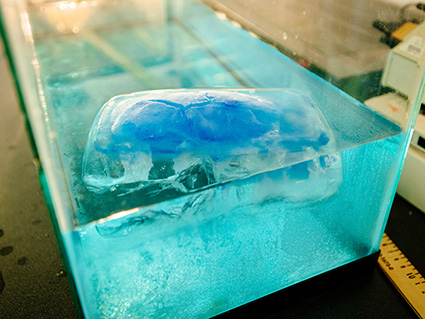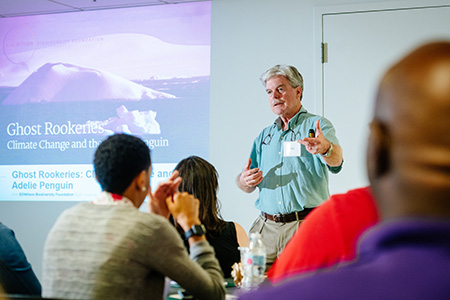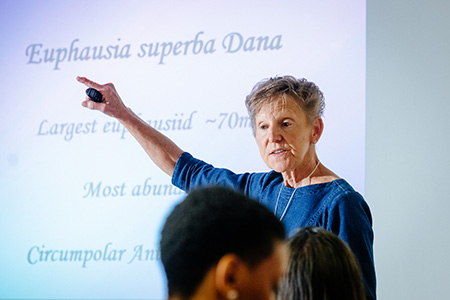 Amsler showed educators several experiments to conduct in their classroom to show the effects of climate change. This experiment shows how water levels do not rise when glaciers melt. But as ice that is on land melts, like in Antarctica, water levels will rise. The National Oceanic and Atmospheric Administration collects terabytes of data every day from weather stations, radar, satellites, ships, buoys and sensors for scientists to use. Educators also have access to these data to use in their classrooms to help teach middle school students about climate change. The question for many of these educators becomes “How do we use the data to show our students the effects of climate change?”
Amsler showed educators several experiments to conduct in their classroom to show the effects of climate change. This experiment shows how water levels do not rise when glaciers melt. But as ice that is on land melts, like in Antarctica, water levels will rise. The National Oceanic and Atmospheric Administration collects terabytes of data every day from weather stations, radar, satellites, ships, buoys and sensors for scientists to use. Educators also have access to these data to use in their classrooms to help teach middle school students about climate change. The question for many of these educators becomes “How do we use the data to show our students the effects of climate change?”
The University of Alabama at Birmingham created a pilot program, Penguins in the Warming World, to help educators integrate climate change into their curriculum through scientific experiments and creative writing. In a summer workshop hosted by a UAB research associate, an educator from the UAB Center for Outreach and Development, and three professors, more than 50 educators from 15 different school districts across Alabama gathered over three days to expand the knowledge of climate change to their students.
“The three days we spent with these educators will impact more than 6,000 students across the state,” said Maggie Amsler, a research biologist in the UAB College of Arts and Sciences. “About half of the educators who attended have never talked about climate change in their classrooms, while the other half were looking for more ways to talk to their students about the impacts of climate change.”
Katie Busch, an educator from the UAB CORD program, noted that educators often have preconceived concerns about teaching climate change.
Amsler opened the workshop with a simple experiment that can be done in the classroom to illustrate the effects of climate warming on global sea level. An aquarium with several inches of water was set up with a brick placed on the bottom to represent Antarctica and a beach fashioned of clay. A large chunk of ice was placed on top of the brick representing glaciers or ice sheets resting on land in Antarctica, and an incandescent lamp was turned on directly above to represent the Earth’s warming. Soon it became evident that as the ice sitting on the brick melted the level of the water in the aquarium rose – indeed, the ‘beach’ in the aquarium was soon flooded.
In a separate experiment, a large chunk of ice was floated in water in an aquarium containing no brick. It soon became evident that as the floating ice melted the level of water in the aquarium did not rise, illustrating that ice that is already in water, like the ice shelves surrounding Antarctica, does not cause water levels to rise.
“We are seeing a warming effect in the Earth’s atmosphere,” Amsler said. “The ice in the experiment represents glaciers to the extreme north or south and how they impact water levels around the world. This simple classroom experiment opens up discussion of critical issues in climate change that are affecting Antarctica and the rest of the world.”
 Jim McClintock, Ph.D., Endowed University Professor of Polar and Marine Biology, discusses how we can inform the next generation to help slow the progression of climate change. Why do students need to know about climate change?
Jim McClintock, Ph.D., Endowed University Professor of Polar and Marine Biology, discusses how we can inform the next generation to help slow the progression of climate change. Why do students need to know about climate change?
Antarctica is changing fast because of the atmosphere’s rapid warming. Both ice features and polar marine life are very sensitive to even small increases in temperature. This makes Antarctica an ideal place to study the effects of global climate change.
Glaciers and ice shelves are melting rapidly causing sea levels to rise even in distant places, like coastal regions of Florida. Warming temperatures can also threaten Antarctic marine life that depend on sea ice, such as krill, and some penguins and seals.
“It is the rapid rate of climate change that is concerning to scientists,” said Jim McClintock, Ph.D., Endowed University Professor of Polar and Marine Biology in the UAB Department of Biology. “Research in Antarctica, led by professors Maggie and Charles Amsler from UAB, Bill Baker from the University of South Florida, and myself, has revealed that Antarctic sea life such as sponges, sea squirts and seaweeds contain compounds that may fight cancer and antibiotic-resistant bacterial infections. Climate warming may allow the invasion of novel predators including king crabs that could eliminate species with promising potential for drug discovery. It is important that we educate the next generation on climate change’s many effects and ways to help slow climate change.”
In the workshop, McClintock discussed the significant role of humans in causing climate change through the production of atmospheric carbon dioxide from the combustion of fossil fuels. However, he was optimistic that climate change can be addressed if we do so soon. McClintock believes the next generation can make a real impact on the future of our planet. He encourages educators to provide their students hope for the future. He urges educators to find common ground with students on issues of climate change by identifying environmental changes that are happening right now, right where they live.
How to use the resources
The National Science Foundation provides a link to Palmer Station, a United States research station in Antarctica, where educators can view Adélie penguins in real time from late October to April each year.
The penguin cam reveals a colony that has been steadily declining as temperatures have warmed the Antarctic Peninsula over the past 50 or so years. However, there are still enough penguins for teachers and students to follow the stages of breeding, nest maintenance, and chick hatching and development — all highly synchronized events during the Antarctic spring and summer. Educators are provided with materials to enable students to explore the relationship between air temperature and the penguin’s various activities during the breeding, egg laying and chick-rearing season.
Moreover, the penguin cam provides a mechanism for following daily activity patterns, where students can view the penguins interacting with one another and follow their unique and fun behaviors, such as stealing each other’s small nest stones to build and maintain their own nests.
Students learn to actively participate in group discussions, develop hypothesis, incorporate new vocabulary terms into their observations, and develop and communicate conclusions, which fall in line with Alabama’s teaching standards.
“Penguins rely on krill as their main food source, and krill feed on algae that is located on the underside of the annual sea ice,” Amsler said. “When sea ice decreases, less ice algae is available for krill, causing the krill population to shrink. This shows a chain reaction of climate change to students and allows for broader discussion.”
 Maggie Amsler, research biologists, works with Alabama educators to integrate climate change conversations into the classroom.Connecting through empathy
Maggie Amsler, research biologists, works with Alabama educators to integrate climate change conversations into the classroom.Connecting through empathy
Adam Vines, associate professor in the UAB Department of English, incorporated poetry and linguistics throughout the day to help educators connect climate change. He used ekphrastic poetry, or poems with vivid descriptions of a scene or work of art, to help students relate to climate change and what is happening around them.
“When we introduce students to science, we need to connect them to the experience, which will hopefully provoke empathy,” Vines said. “We look at the data as a scientist, but it’s critical to integrate the science into stories. That’s what’s relatable. Using language to imagine yourself in a situation and learn from it. It makes science fun through language, resonating with everyone.”
By combining science and language, students are able to use words to create a different narrative that evokes emotion. Educators can create more of a personal moment through the metaphors and conveying the senses and emotions.
Vines walked the participants through an exercise to develop their own poem. He asked them to come up with three verbs related to science, then they employed those verbs to express or describe the scene in a photograph metaphorically or literally grounded in an ecological concern.
“By using a language from a lexicon to move an idea from one to another context that the writer is describing, the writer can transform common objects or places, while retaining their integrity, and start forming figurative underbellies,” Vines said.
Educators were provided with digital materials and instructions on how to incorporate climate change education in their classrooms. To evaluate the effectiveness of the workshops, Scott Snyder, Ph.D., associate dean of the UAB School of Education, is carrying out a rigorous analysis of educator learning outcomes and implementation of the curriculum in the classroom.
The three one-day workshops were funded by UAB, the Susan Mott Foundation and the McWane Science Center.